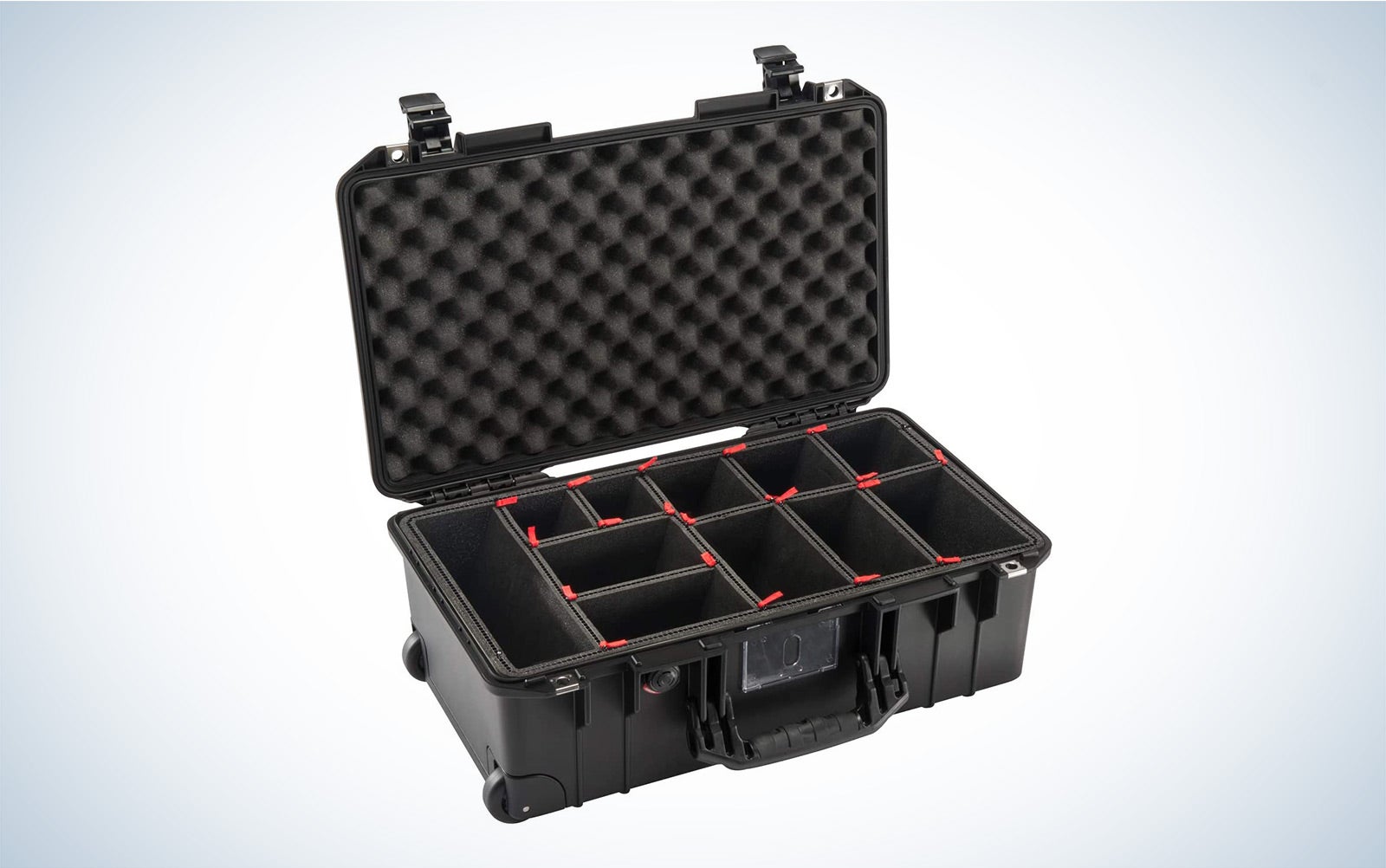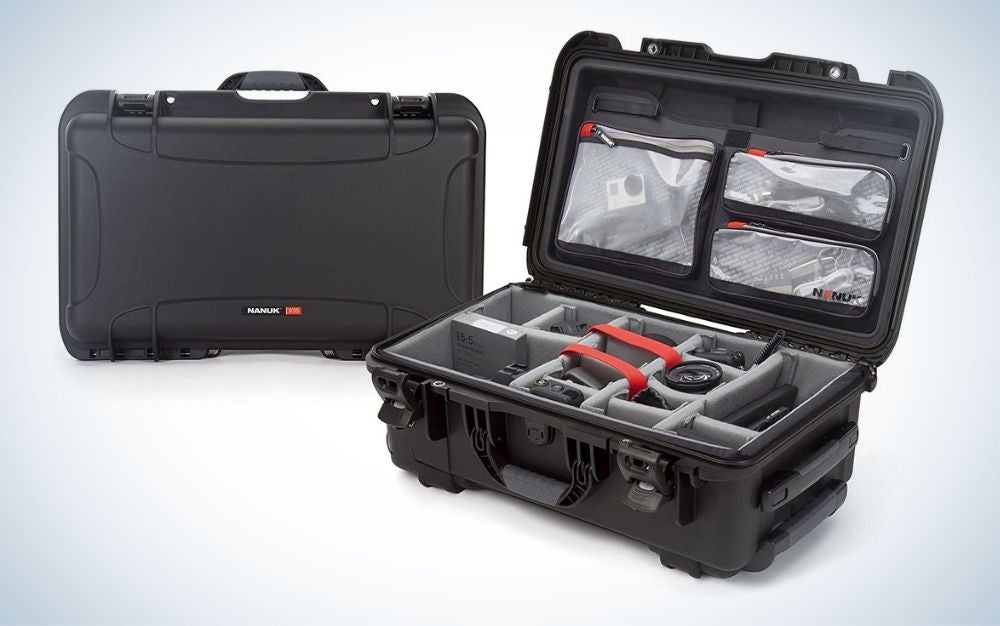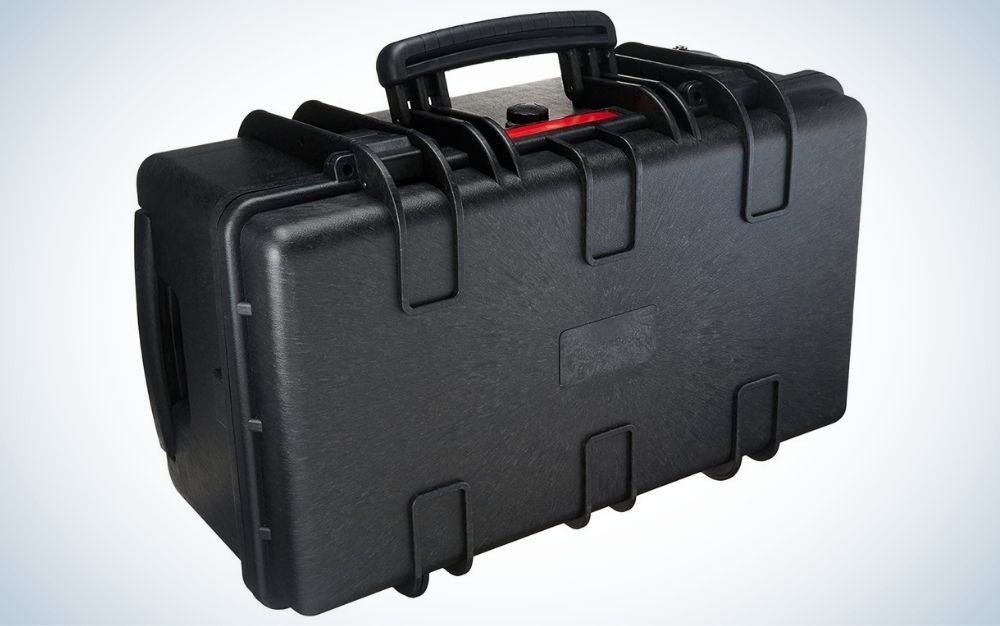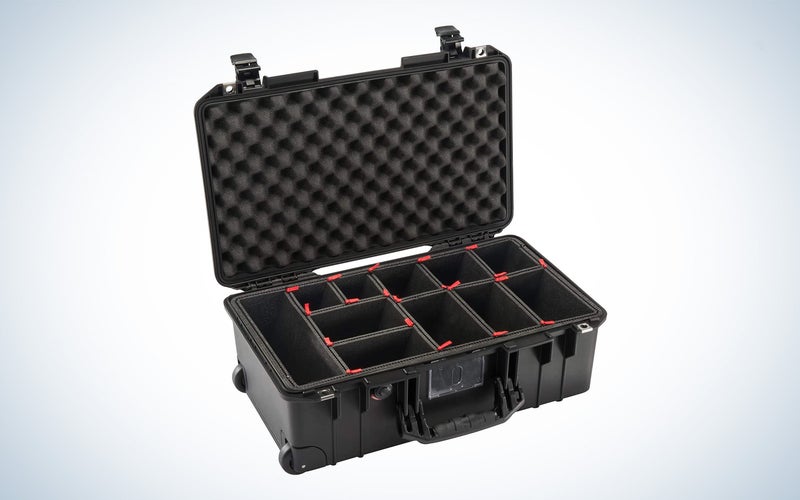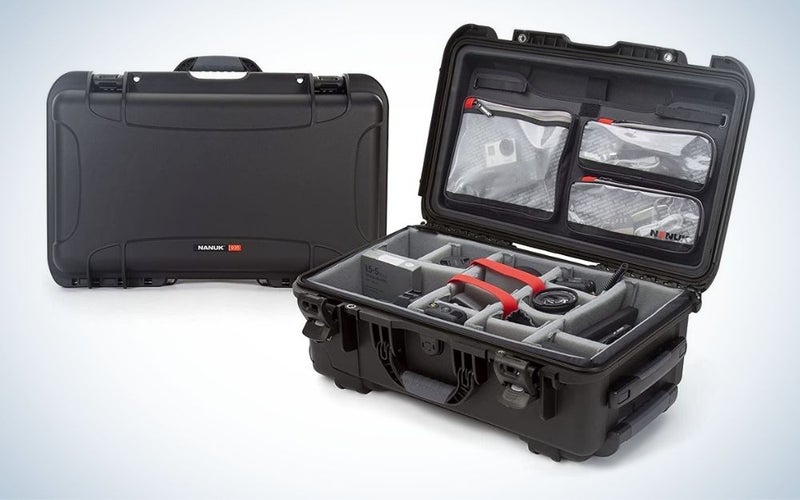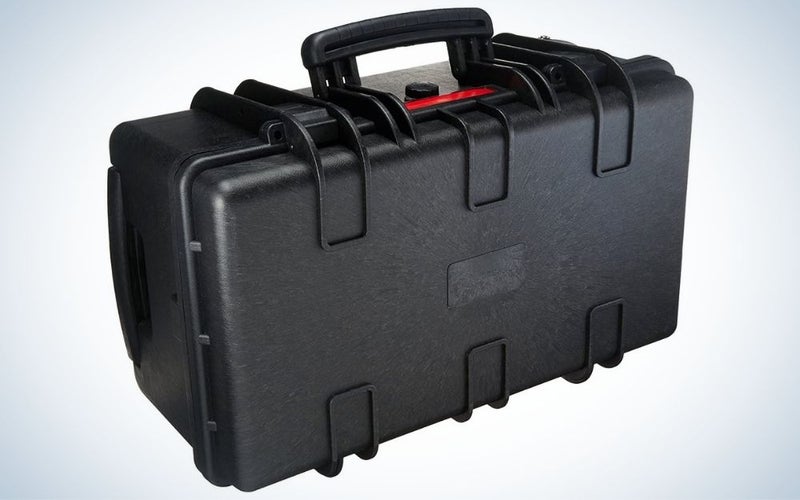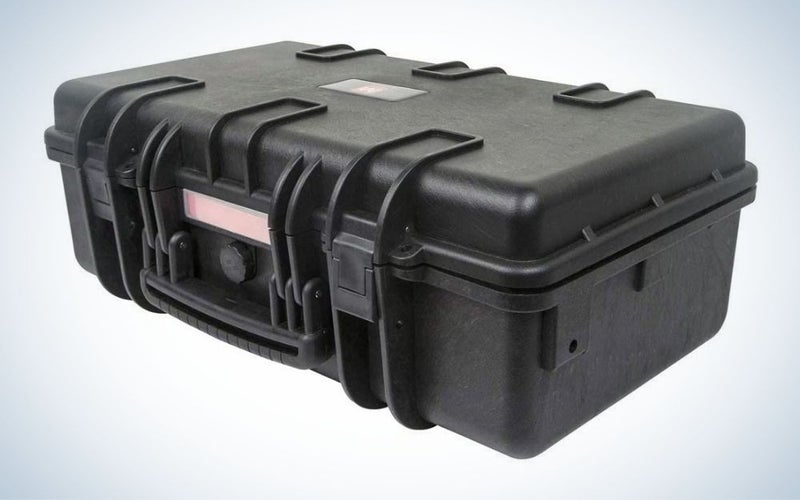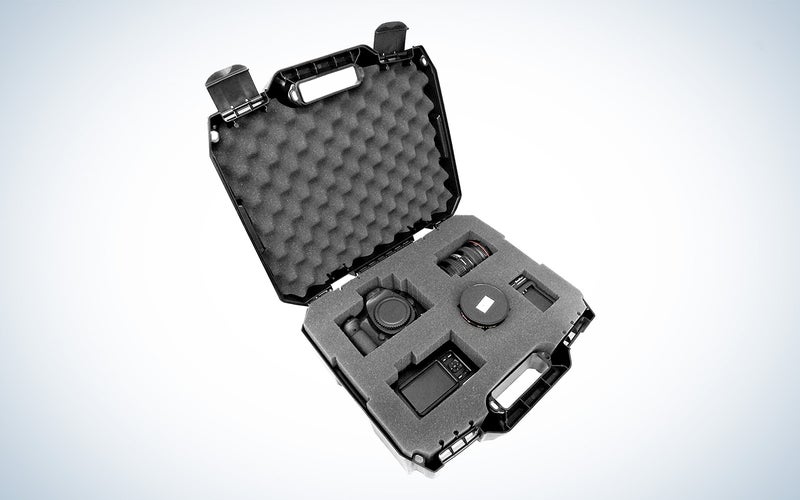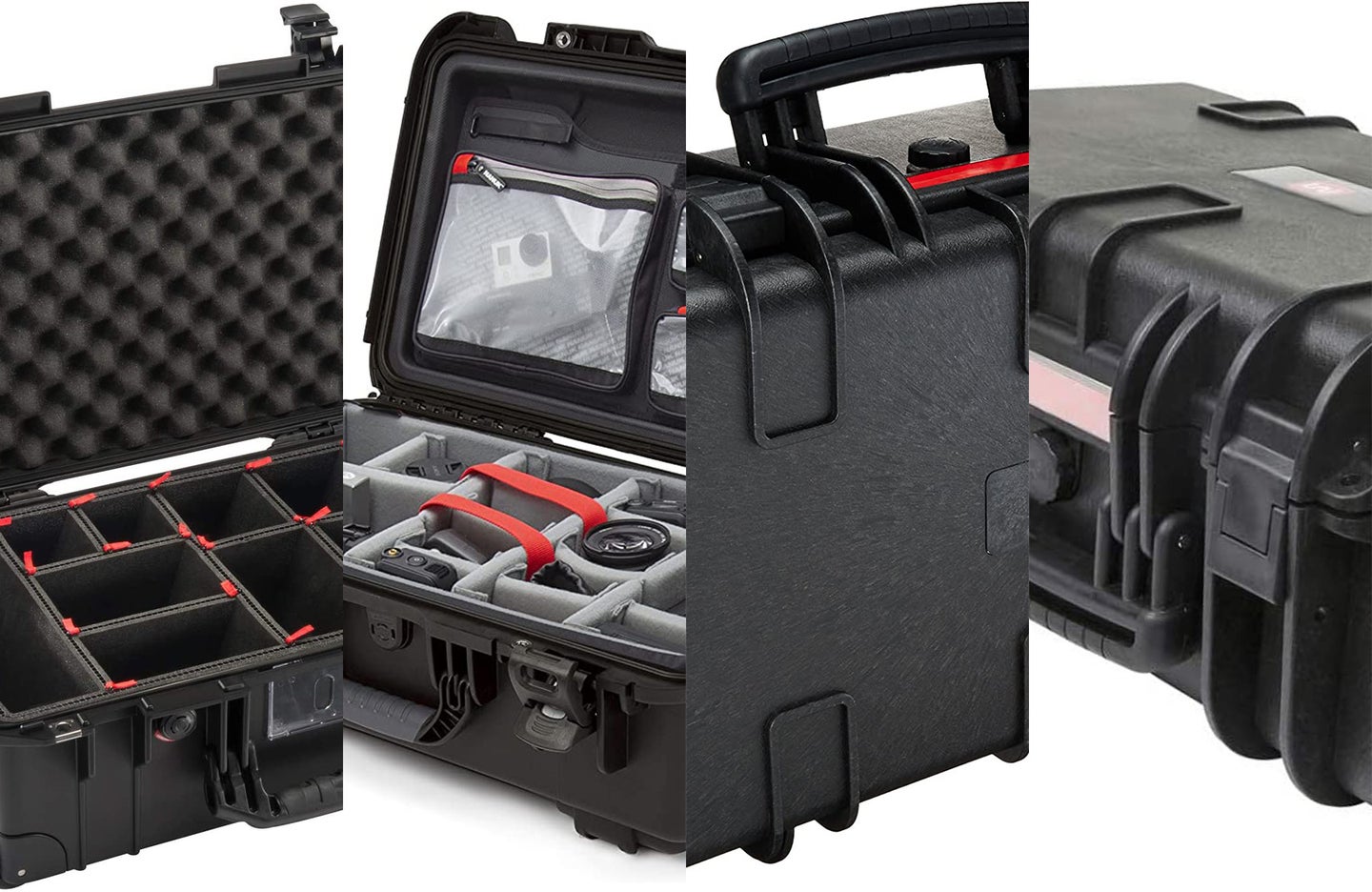
We may earn revenue from the products available on this page and participate in affiliate programs. Learn more ›
It’s no secret that photo gear is quite the investment—cameras alone frequently cost thousands of dollars, which is why a camera case is so critical. With super-sensitive equipment that makes all the difference in producing a quality shot, you want to be sure your camera is protected and secure. Whether you’re hauling your cameras through inclement weather or tossing it in an overhead airplane compartment, a camera case can make all the difference in safeguarding your gear.
These weather-resistant, waterproof cases are designed to take a beating while keeping everything inside secure. A good case should also be easy to carry, easy to organize, and easy to store in a studio or on a flight. Even if you only use your camera for casual photography, a hard case is a handy way to keep equipment safe from bumps and falls. Cameras and lenses are precious and delicate instruments and must be treated as such. Defend your photography gear against the forces of nature—and the forces of gravity—with the best camera case.
- Best overall: Pelican Air 1535 Case With TrekPak Dividers
- Best for travel: Nanuk 935 Waterproof Carry-On Hard Case with Lid Organizer
- Best for studio photographers: Amazon Basics Large Hard Rolling Camera Case
- Best for beginners: Monoprice Weatherproof Shockproof Hard Case
- Best small: CASEMATIX Cam Hard Case
Methodology: How we picked the best camera cases
The writers and editors at PopPhoto have been involved in most aspects of the photography industry for decades. Throughout that time, we have had to figure out ways to protect our stashes of gear for a variety of shoots and adventures.
While assessing camera cases, we prioritized options that offered an IP67 rating for ultimate protection. We also looked for companies that offer various sizes so that you can choose which is best for your gear. Cases with padlock holes, sturdy hinges and latches, and smooth-rolling wheels were also important in our decision-making process. Lastly, we relied on a mix of personal experience, user reviews, and editorial reviews for narrowing down the products on this list.
The best camera cases: Reviews & Recommendations
Best overall: Pelican Air 1535 Case With TrekPak Dividers
Pelican
Why it made the cut: It’s ridiculously lightweight for its size and still extremely durable. Plus, this size meets airline carry-on requirements, so you can pack all your gear without checking it.
Key features:
- Outer dimensions: 21.96 x 13.97 x 8.98 inches
- Interior dimensions: 20.39 x 11.20 x 7.21 inches
- Empty weight: 8.69 pounds
- Waterproofing: IP67 rated
Pros
- Lightweight
- Has wheels and an extending handle for travel
- Airline carry-on compatible
- Different types of interior padding available
Cons
- Pricey
When you get into larger sizes, camera cases get quite heavy. Even on wheels, it can make lugging around a case cumbersome and difficult. But, Pelican managed to create a proprietary Polypropylene blend that weighs substantially less than any similar case. In fact, Pelican claims it’s 40% lighter than other polymer cases. And after moving from Hawaii to Florida with the larger version of this case, I can attest to how shockingly light it is. Even with it crammed full of gear and clothes, it was very manageable to pick up and carry when needed.
You might worry that because of how lightweight it is, you lose out on durability and ruggedness, but that is decidedly not the case. Like other Pelican cases, it is crushproof, waterproof (rated to IP67), and dustproof. And it has an automatic pressure equalization valve to keep the internal pressure balanced and still keep water out.
Pelican has three interior organization types: Its Pick N Pluck foam, padded dividers, or TrekPak dividers. I’m partial to the dividers because they allow you to rearrange as often as you like. The foam is very protective, but once you pluck it out, you’re stuck with that configuration. The TrekPak system is easy to set up and customize and does a great job of securely holding your gear. I had mine stuffed with spare clothing, but still, none of my gear seemed to have budged.
The case also has stainless steel padlock protectors, so you can lock your case to protect all that expensive gear (just make sure you get TSA-approved locks if flying). Lastly, it has smooth rolling wheels and a retractable handle for smooth airport travel. But, of course, the downside to all that quality and security is that it is quite costly. It’s an investment, but it is worth it to trust your gear will be safe.
Best for travel: Nanuk 935 Waterproof Carry-On Hard Case with Lid Organizer
Nanuk
Why it made the cut: Bring everything you need and then some with the Nanuk 935 camera case.
Key features:
- Outer dimensions: 22 × 14 × 9 inches
- Interior dimensions: 20.5 × 11.3 × 7.5 inches
- Empty weight: 11.6 pounds
- Waterproofing: IP67 rated
Pros
- Available in different colors
- Different interior organization options
- Optional lid organizer add-on for more storage
- Strong, easy-to-use latches
Cons
- A bit heavy
If you’re going on a long trip or about to embark on a hectic week of shooting, the Nanuk 935 becomes your rugged travel studio. This Nanuk case has interior dimensions of 20.5 x 11.3 x 7.5 inches. Should you need even more room, Nanuk makes a wide range of sizes, up to its 965 case, which is 29 x 18 x 14 inches on the inside.
The bonus of this case is that it comes with a lid organizer. It is a big help for organizing your chargers, GoPros, extra lens caps, or any other small accessories you need during your trips. And it even has a padded laptop compartment, so you can safely bring your computer along. You can choose a version without the or, but it’s a nice feature to have when traveling.
The latches on Nanuk’s cases are something that people rave about. Users say they are tougher and easier to work with than Pelican’s latches. You’ll be able to trust that it will stay tightly closed even with the rowdiest of baggage handlers. Its wheels and a retractable handle work smoothly and make racing through the airport less frantic.
Finally, and perhaps most importantly, the IP67-rated seal keeps dust and water out. The case can be safely submerged in 3 feet of water for up to 30 minutes. Plus, it’s buoyant up to 58 pounds, so you won’t need to go diving to get it back.
For even more options for your travels, check out these travel cases for camera gear.
Best for studio photographers: Amazon Basics Large Hard Rolling Camera Case
Amazon Basics
Why it made the cut: This affordable camera case gives all of your gear a safe place to stay, even in the studio.
Key features:
- Outer dimensions: 21.9 x 13.7 x 9.8 inches
- Interior dimensions: 20.5 x 10.8 x 7.5 inches
- Empty weight: 15.45 pounds
- Waterproofing: IP67 rated
Pros
- Affordable
- Comes with pre-cut foam
- Rubberized handle for a better grip
Cons
- Heavy
You may be surprised at how strong this Amazon Basic camera case is, especially for the price. It is rated to IP67, meaning it can be submerged in up to three feet of water for three minutes and still protect your precious gear. The case has all the features of brand name boxes and is (almost) as strong. It won’t be quite as durable as the Pelican or Nanuk but is plenty rugged for going to and from the studio.
The interior size is 20.5 x 10.8 x 7.5 inches, which fits carry-on requirements should you need to travel with it. It is heavy, though, so keep that in mind. The included foam can be cut and adjusted to fit all your extra lenses and spare camera bodies. Should you use this on a mountain climbing expedition or worldwide travel? Probably not. But the case provides substantial protection for storing camera bodies and extra photography gear at home or in the studio.
Best for beginners: Monoprice Weatherproof Shockproof Hard Case
Monoprice
Why it made the cut: It’s very affordable but still offers full protection for your expensive gear.
Key features:
- Outer dimensions: 22 x 14 x 8 inches
- Interior dimensions: 20.1 x 10.9 x 6.8 inches
- Empty weight: 10.91 pounds
- Waterproofing: IP67 rated
Pros:
- Very budget-friendly
- Comes in four different colors and seven sizes
- Shockproof
Cons:
- Lid doesn’t align perfectly, resulting in sealing issues
The Monoprice camera case is the Goldilocks of camera cases—it’s not too big, not too small, not too heavy, not too flimsy. It’s just right. For anyone new to photography who wants a case they can experiment with to find the right arrangement, the Monoprice is a great place to start.
It comes in four colors, and should this particular size not suit your needs, there are plenty of other options available. For this specific model, the internal 20.71 x 10.83 x 6.67 inches of space is enough for two DSLR cameras with room to spare. It’s made of UV-resistant polypropylene and is durable enough to stand on (though maybe don’t test that). It also has a customizable name plate so you can put your information on it in case it gets lost.
Unfortunately, the included foam isn’t the best, so you may want to replace it with Pelican inserts for optimum protection. Also, some have reported that the lid doesn’t line up perfectly, resulting in latching and sealing issues. As a result, it isn’t the best option if you have expensive gear or will be in a wet environment. But, it will absolutely do the job for beginners who just need a basic case that won’t cost an arm and a leg.
Best small: CASEMATIX Cam Hard Case
CASEMATIX
Why it made the cut: It’s a simple case for small cameras and lenses and is very inexpensive.
Key features:
- Outer dimensions: 16 x 13 x 6 inches
- Interior dimensions: 14 x 11 x 4 inches
- Empty weight: 3.6 pounds
- Waterproofing: None
Pros:
- Has padlock rings for locking
- Very budget-friendly
- Small and easy to carry
Cons:
- Not waterproof
This Casematix camera case is a very affordable option. Of course, going that cheap means you’re giving up size and some durability, but as a hard case, it still offers more protection than a backpack. The shell is made from hard polymer composite plastic, which Casematix claims is crushproof.
This case comes with pre-cut pluckable foam, so you can customize the layout to whatever gear you need to protect. Of course, as a smaller case, you won’t be able to fit a ton of equipment. But it will hold a camera, lens, and a few essential accessories. It will also be easy to hold and carry around because of its compact size, which is a plus. And, should you want to, you could even throw the case in a backpack.
The downside of this budget camera case is that it isn’t fully waterproof. There are no watertight seals, so you won’t want to submerge it. The plastic case will protect against some light showers, but definitely take care to avoid downpours and bodies of water. However, if you only need a simple carrying case to protect against typical bumps and scuffs, the Casematix camera case is an affordable solution. And for the price, you might as well buy a few to keep your home studio organized.
What to consider when shopping for the best camera case
How should you store and transport your camera and camera accessories? Picking the right camera case depends on a handful of things: the size and amount of equipment, where you’ll be taking it, the material of the case, and the price. The best camera case will suit your needs and make a photo session or trip as painless and damage-free as possible.
Should you use a camera case or a camera bag?
The big difference between a camera case and a camera bag is durability. Camera slings, shoulder bags, and camera backpacks are great for carrying photography gear on your person and will offer some protection against bumps. They are typically soft-sided, though they provide padded dividers inside the pack. They also generally have storage space for things beyond cameras and lenses, such as dedicated laptop sleeves and space for water bottles and jackets. However, hard camera cases are larger, tougher, airtight vaults offering the highest caliber of protection.
Hard camera cases provide optimal storage solutions for your photography equipment when traveling or storing gear. They are waterproof and crushproof beasts that laugh in the face of even the rudest airport baggage handler. They stand up against torrential rain, and most will even keep camera equipment dry if the case is accidentally dunked in a river or lake. There are also some very large options, meaning you can store most or all of your gear in a single case.
While oversized hard cases have their uses, a big, robust case is overkill if you only use a point-and-shoot camera or small camera bodies and pancake lenses. They also don’t make much sense for things like backpacking trips. But if your current camera bag is bursting with photography equipment, it’s time to upgrade to a roomy and secure case.
What size case do you need?
Knowing what size case to get will depend on how much and what type of gear you need to put in it. For example, you’ll need a big case if you have large DSLRs with long telephoto lenses and lots of accessories. Likewise, lighting equipment can be bulky and take up a lot of space. But if you have a compact mirrorless camera and a few small lenses, something small will be fine. Where you need to bring your case may also impact what size you should get. Luckily, the best camera cases come in a variety of sizes, so you can pick one that’s best for your needs.
Of course, bigger cases will give you more space. These are great for photographers with a lot of camera gear to pack but will cost more. And if you don’t have enough stuff to fill the case or you don’t have large enough foam inserts, it may be more difficult to keep everything inside secure. Think of a shoebox filled with shoes vs. a shoebox filled with a few marbles. That could result in damaged gear, so make sure to get a case–and dividers–that are appropriately sized for what you will be putting in it.
For traveling, an exterior size of approximately 20 x 12 x 8 inches is the perfect dimension for most carry-on luggage but always check with the airline first. Depending on your gear, that may be large enough to pack some extra clothes or other necessities but isn’t so large that it’s too cumbersome.
Material matters: It’s what’s on the inside–and the outside–that counts
Is the outer shell up to the challenge without weighing a ton? Polypropylene blends are good for rugged protection without the weight of heavier plastic and metal materials. If you are using the case for travel, you’ll want a material that results in a crushproof case. A sturdy camera case should also be watertight and airtight. If airtight, it should have an automatic pressure equalization valve for any significant changes in air pressure (e.g., air travel). And the airtight seal should be rated at IP 67 or above, meaning dust and water can’t get inside.
The interior of the case should also be customizable and protective. Pick and pull foam padding allows you to lay out the case however you’d like, but once you pull out a piece of foam, you’ll be stuck with that layout. Soft removable panels can be used to organize the camera case and are easy to adjust and reorder as you change your gear. Both types provide plenty of protection for your equipment, depending on how you arrange it.
Do you need a portable case?
Hard camera backpacks are an excellent tool for photographers needing on-the-go durability. But any wearable case must be comfortable, and some hard cases will dig into your shoulders at an uncomfortable angle. So when possible, you’ll want to try on a hard backpack case before you buy to check how it fits. And be sure to make the proper size adjustment to avoid injury and annoyance. Also, know that some so-called hard shell backpacks are only reinforced on the outside panel. As a result, the entire pack is not crushproof, leaving your gear at risk.
Rolling camera cases are pure magic when lugging equipment through airports and train stations. They’ll keep you from awkwardly carrying the case in your arms while juggling other bags.
Lastly, consider the need for laptop space or additional storage. Some cases can easily hold a laptop in a designated pouch or compartment, while others are strictly camera equipment-only. Shoving a laptop on top of your equipment could cause damage or scratches to either or both.
FAQs
How much does a camera case cost?
How much a camera case costs depends significantly on its size. And, as with any product, it also varies based on durability and features. But, broadly speaking, you can buy a camera case anywhere from $25 to $500. A higher price will get you more storage space and typically better protection.
How many camera cases do I need?
How many camera cases you need is dependent on how much gear you have. You can easily get away with one smaller case if you have a single camera, a few lenses, and basic accessories. However, you may need two or three large cases (or even more) if you have multiple cameras, lots of lenses or multiple large lenses, lighting equipment, and many accessories.
What are camera cases made of?
The shells of today’s hard camera cases are typically made of industrial-grade polypropylene blends. This stuff is tough enough to withstand being dropped down a flight of stairs or a small hillside. Most of them will even support your body weight if you should want to stand or sit on them. And despite their strength and durability, the best options don’t weigh a ton. The interior components vary across brands–and even within brands–but typically are a foam material that offers shock absorption, cushioning, and organization.
What is the best way to protect your camera?
A hard case is the best way to protect your camera. The outer shell can withstand whatever mother nature can dish out. But even if you stay indoors, a hard case is ideal for protecting against drops and the weight of other things getting set on top.
You can also keep dust and water away from your equipment by using a case with an International Protection (IP) rating higher than 65. The IP rating is how the integrity of the seal is graded. Anything above IP65 will keep out dust particles and torrential rain. With an IP rating of 67, a case can be submerged in 3.2 feet of water for as long as 30 minutes.
What is the best camera case for traveling?
The best camera case for traveling needs to be rugged and rolling. Baggage handlers and luggage carousels are brutal on camera gear. But a strong case with a well-fitted interior is more likely to safely make it through the journey. Many camera cases are sized to fit in overhead compartments and can be used as carry-on luggage. You’ll also want a case with wheels and a retractable handle that’s easy to deploy. The Nanuk 935 Waterproof Carry-On Hard Case checks all those boxes.
Final thoughts on the best camera cases
Whether venturing outside or staying in a home studio, keeping your camera equipment protected with the proper case is essential. While bags, camera slings, and backpacks are great for carrying gear around, sometimes you need the rigid protection only found in a hard waterproof camera case. Be sure to measure your cameras and look at the specs of the cases to ensure everything you need will fit comfortably.
The post The best camera cases in 2022 appeared first on Popular Photography.
